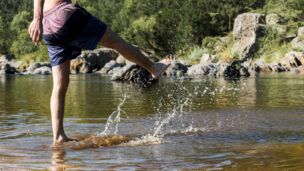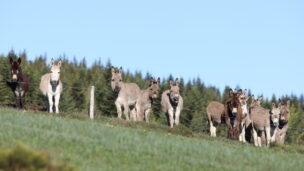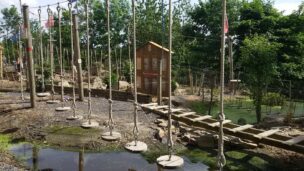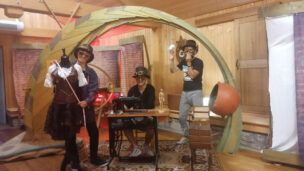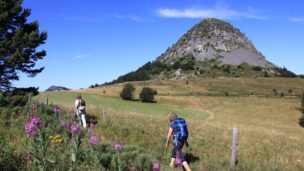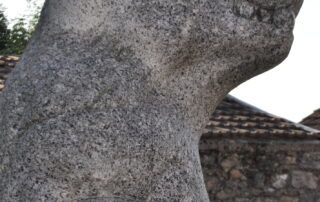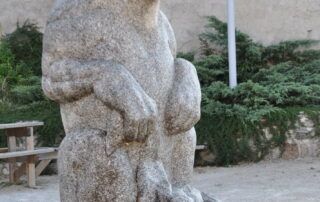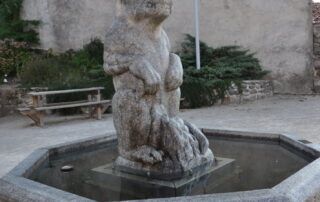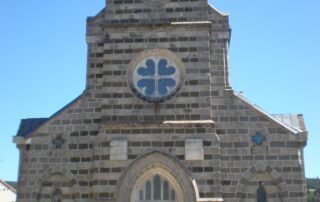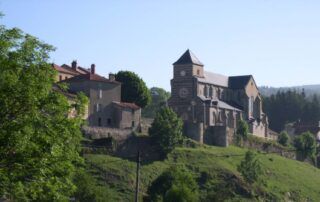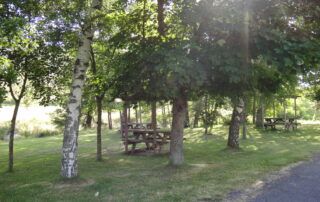Description
The victim was buried “without sacraments”, that is to say without having been able to receive the sacrament of Extreme Unction, having been killed by the animal before the arrival of the priest. However, on the recording of her death by the parish priest, we note that she was the victim of the ferocious beast, which suggests that she was not the first real victim but only the first declared... There followed a carnage which will terrorize the region for three years…
Some assume (without any proof has yet been provided) that a man had trained one or more animals from crosses between dogs and wolves by teaching them to feed on human flesh. Some clues could suggest that this man or these men would have been sexually deranged (according to unofficial testimonies, the "beast" undressed some of his victims). Several cases of decapitation are reported. Among the suspects is a family unfavorably known in the region, the Chastels. The imprisonment of the Chastels (of short duration, for reasons of contempt of the authorities who had come to hunt the beast) did not, however, have any notable effect on the attacks.
Other hypotheses evoke more simply one or more wild animals: wolves, hybrids of wolves and dogs, hyena, bear, lion, monkey, escaped from the hands of their driver. Unless some criminals have taken advantage of the circumstances to put their own crimes on the account of animals.
Given the magnitude of the case, the authorities decided to call on various hunters to organize hunts in which more and more people took part. Dragoons, wolf-boys and the king's arquebus carrier then followed one another to "run after the Beast that ate the world". The results were, to say the least, disappointing, in spite of the continuous beatings (those of 1765 counted up to thirty thousand people, peasants for the most part). arquebus holder of the king, François Antoine (often called, by mistake, de Beauterne). The "Beast", or at least what took its place since the animal killed was indeed a wolf, was naturalized and sent to Versailles and deposited in the King's Cabinet, the future National Museum of Natural History. For King Louis XV and the Court, the case was closed. However, the attacks resumed in December 20. The authorities then lost interest in the affair, concluding that they were coincidences. The country of Gévaudan was going to have to live almost another two years with "its Beast", this one however, officially killing "only" six people in 1765 and eighteen during the first six months of 1765.
Finally, on June 19, 1767, during a hunt sponsored by the Marquis d'Apcher in the woods of Ténazeyre, at a place called Sogne d'Auvers, it was Jean Chastel (who had previously been imprisoned as well as 'it was said), a man from the hamlet of Besseyre-Saint-Mary, who slaughters a very large wolf-like animal. Thereafter, novels related the story, telling this strange man and suspecting him of witchcraft, making him use a holy bullet. It is, however, established that the assaults ceased from that date.
Besides the fact that the Beast claimed a considerable number of victims, many details about it are curious:
Its morphological nature: it is certainly a canine, but with an unusual appearance. It could be a hybrid of dog and wolf (see report by notary Marin, written in the hours following the death of the Beast). It should be noted that many witnesses, accustomed to the presence of wolves in their countryside, did not recognize a wolf in this animal, but directly named it under the term bestia, "the beast" in langue d'oc.
Her relative invulnerability: the lack of effectiveness of weapons has led to the assumption that she may have worn a breastplate made of boar skin, as wore by dogs used in warfare until the beginning of the XNUMXth century. The boar hair, called “the stuffing”, very thick and tight, is a very effective protection even against bullets. Another element weighs in favor of this hypothesis: among the descriptive elements that come up in the testimonies, is that of a coat with a black stripe all along the backbone. This element, which was not observed on the body of the animal and does not correspond to the coat of the wolf, is on the other hand characteristic of that of the boar.
Its ubiquity: the beast is seen in a very short time interval in places several kilometers apart from each other. These distances, although important in certain cases, remain however possible for a single animal.
Her familiarity, her audacity: she doesn't seem to fear men. When the beast meets resistance from the victim or its companions, it moves away "40 paces", sometimes sits on the rear end for a few moments and, if not pursued, returns to load. She moves away from the place of her crime at a short trot or at a walk. At least twenty-two times, victims were attacked in the middle of the village and almost all the attacks took place during the day. None of these behaviors correspond to that of large predators in the wild.
Its aggressiveness: the "Malebête" does not seem to attack only under the impulse of hunger and shows great relentlessness.
Its cannibalism: if it also attacks animals, it does not feed on them while it devours its human victims.
His agility: exceptional in the eyes of witnesses.
The human staging in certain murders: naked victims whose clothes, not torn, are placed at a distance (according to unofficial or authenticated sources) and beheadings (the head cut off cleanly), a practice never observed by etologists on large carnivores (wolves, lions, etc.).
Some indications lead to the Chastel family. Jean Chastel's two sons led two game wardens to a bog where they almost died, while the two brothers looked at them without coming to their aid and even laughing at them. The father was also imprisoned following this event. Jean Chastel could even have planned the death of the beast: according to tradition, he had the bullets with one of which he killed the beast blessed on June 19, 1767. He even claimed to have melted holy medals to make the bullets he used. Anyway, the animal was killed from the front, in conditions tending to suggest that the monster was familiar with its hunter. Moreover, his death is supposed to be the consequence of a search that would have taken place in the woods of Ténazeyre and which brought together 12 men, including Father Chastel. However, these woods, whose area is already very large, are part of the immense forest that surrounds Mont Mouchet, the Margeride forest. Thus, even if this forest was at the time less dense and extensive than today, the probability that an animal at bay will be caught in the meshes of the net of such a modest hunt over such a large area is almost nil.
An indication for a possible connection between this beast and a master is the fact that it escaped the gigantic hunts of the year 1765.
Despite the fact that period sources are sometimes unreliable or misinterpreted, particularly on the exact locations and scenes of carnage, a certain number of points make it necessary to favor a range of probabilities which draw a picture which no doubt approaches reality.
The supernatural hypothesis is not taken into account.
Attacks cannot all be the work of a man (all the people who survived an attack described an animal in the authenticated testimonies).
It seems that the aggressions have various origins: classic attacks of wolves, but especially attacks of a particular beast. We obviously cannot exclude, but this is not proven, attacks by one or more criminals taking advantage of the context.
The hypothesis of a staging in the case of the beast killed by François Antoine is possible, but not proven by archival documents. On the other hand, the use of a wolf of spectacular size (brought from the zoo of Paris) rests only on conjectures without evidence. Indeed, the zoo of Vincennes was born from the colonial exhibition of 1931 and the menagerie of the Jardin des Plantes only saw the light of day under Napoleon I.
The beast killed by Jean Chastel could have been an animal tamed and trained to kill, according to some theories; in any case, its description is, obviously, that of a canine.
There is no evidence to accuse the local nobility who would have covered up his actions.
The use of the term "beast" (instead of "wolf") by some witnesses, when this animal well known in the countryside of the time should have been identified without question, is more than disturbing. Moreover, wolves generally hunt in packs, and it is accepted by specialists that attacks by wolves on human beings are very rare. The wolf, even hungry, indeed fears the human, especially if he is alone in front of him.
The fact that all the victims who did not survive the attacks were women and children, if it may at first glance make one think of the work of a sadistic killer, is no doubt explained by the circumstances of the attack. era: these victims – often very young – kept the herds alone and were therefore easier prey than the men working, most of the time in groups and equipped with tools (scythe, pitchfork, axe, etc.) that could easily become weapons of defense.
Anyway, Jean Chastel killed a beast recognized as THE Beast by many witnesses, including survivors of attacks, whose description mentions that it looks like a wolf but is not one. , and the attacks ceased from then on.
However, in 1819, in a small booklet sold for one franc at the Jardin des Plantes, one could read: "Description of what is remarkable in the Menagerie and the Cabinet of Natural History, concerning the life and habits of Ferocious animals which are enclosed both in the Menagerie and in the Swiss Valley: Followed by the Curiosities which are in the Cabinet of Natural History. Imprimerie J. MORONVAL, Paris, 1819.” on pages 5 and 6: “5. The Eastern Barred Hyena.- … This ferocious and indomitable animal is placed in the class of the cervier wolf; he lives in Egypt, he roams the tombs to pull out the corpses; by day it attacks men, women and children, and devours them. He wears a mane on his back, barred like the royal tiger; this one is of the same species as the one we see in the Natural History cabinet, and which devoured a large number of people in Gévaudan”. This small booklet can still be consulted at the Central Library of the National Museum of Natural History, 38 rue Geoffroy Saint Hilaire Paris 5, where it is archived under the call number: 8° Res. 48.
However, the hyena hypothesis leads nowhere: the animal killed by Jean Chastel, which was indeed the one identified by the survivors of the attacks, was autopsied. However, the reading of the autopsy reports of the notary Roch Etienne Marin, with regard to the teeth of the slaughtered animal, formally excludes that it could be a hyena.
The aspect, the ferocity and the "intelligence" (rare are the living beings who kill otherwise than to feed), and the fact that the beast does not seem to fear the man could make think of the glutton. But it is difficult to accept this hypothesis. An adult measures 45 centimeters at the shoulder and weighs between 15 and 28 kilos, far from the description of the Beast. In addition, its appearance is that of a small bear and not a canine. Belonging to the weasel family, it has 38 teeth.
Opening
All year, every day.
We also offer:
Location










